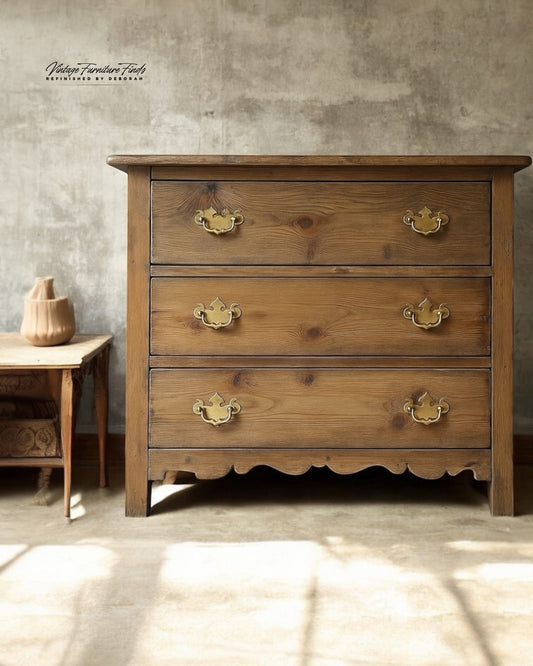
Wood Furniture Restoration: A Guide to Removing Oil Stains and Bleaching with Oxalic Acid
Wood furniture often tells a story, but it can also come with blemishes like oil stains, watermarks, or uneven finishes. Removing oil stains and bleaching wood are essential steps in refinishing and restoring furniture to its full potential. In this blog, we’ll cover effective techniques for dealing with oil stains and demonstrate how to bleach wood with oxalic acid for a lighter, modern look or to even out wood tones.
Shop My Favorite Stain Removal Products Here
I always keep these items stocked because you never know what’s lurking under a finish!
Part 1: How to Remove Oil Stains from Wood Furniture
Oil stains can be tricky to remove, as they require breaking down the residue with solvents or degreasers. Unlike water or tannin stains, which can be treated with oxalic acid, oil stains demand a specialized approach.
Steps for Removing Oil Stains
1. Clean the Surface
• Use warm water and mild dish soap to remove surface grime. Dry thoroughly with a clean cloth.
2. Apply a Degreaser or Solvent
• Mineral Spirits: Rub the stain with a cloth soaked in mineral spirits, following the wood grain.
• Baking Soda or Cornstarch: Sprinkle one of these absorbents over the stain, let it sit for several hours or overnight, then brush or vacuum it off.
3. Sand if Necessary
• For deeply embedded stains, lightly sand the area with fine-grit sandpaper (220 grit). Be cautious to avoid over-sanding.
4. Refinish
• After removing the stain, reapply a finish or stain to restore the wood’s appearance.
Pro Tip: Oil stains and watermarks often appear together. Address the oil stain first, then treat watermarks or discoloration with oxalic acid.

Part 2: Bleaching Wood Furniture with Oxalic Acid
Bleaching wood with oxalic acid is an excellent way to even out wood tones, remove stubborn stains, or create a brighter look without damaging the wood fibers.
Why Oxalic Acid?
Unlike chlorine bleach, which can harm wood fibers, oxalic acid is a gentle yet effective option. It’s particularly suitable for restoring vintage furniture or preparing pieces for refinishing.
What You’ll Need
• Warm Water
• Non-Metallic Mixing Container
• Protective Gloves and Safety Glasses
• Sponge or Soft Brush
• Baking soda
• Clean Cloths
• Sandpaper (optional)
Step-by-Step Guide
1. Prepare Your Workspace
Ensure good ventilation and protect surfaces with a drop cloth. Wear gloves and safety glasses.
2. Clean and Sand
Clean the furniture to remove dust, dirt, and old finishes. Lightly sand the surface if needed for better penetration.
3. Mix the Oxalic Acid Solution
Dissolve 2 tablespoons of oxalic acid crystals in 1 cup of warm water. Stir until fully dissolved.
4. Apply the Solution
Use a sponge or brush to apply the solution evenly, focusing on stained areas.
5. Let It Sit
Allow the solution to sit for 20–30 minutes. Repeat for tough stains.
6. Rinse Thoroughly
Rinse with clean water and let the wood dry completely.
Best Way to Neutralize Oxalic Acid:
1. Mix a Neutralizing Solution – Dissolve 1 tablespoon of baking soda per cup of water (adjust as needed).
2. Apply with a Sponge or Rag – Wipe the wood thoroughly with the solution, ensuring all treated areas are covered.
3. Rinse with Clean Water – Use a separate damp cloth with clean water to remove any remaining residue.
4. Dry Completely – Allow the wood to dry before sanding or applying a finish.
This method effectively stops the bleaching action of oxalic acid and prevents potential issues when applying stains or finishes.
Final Steps
• Inspect the surface for remaining stains and repeat if necessary.
• Lightly sand to smooth any raised grain caused by bleaching.
• Seal or stain the wood to preserve its tone or enhance its color.
Combining Techniques for Stunning Results
For furniture with both oil and water stains:
1. Remove the oil stain using a degreaser or mineral spirits.
2. Once the oil is addressed, bleach the wood with oxalic acid to lighten watermarks or dark stains.
By combining these techniques, you can transform even the most neglected pieces into stunning, one-of-a-kind furniture.
Tips for Success
• Always test solutions on an inconspicuous area first.
• Work in small sections for even application.
• Patience is key—allow time for each step to show results.

Restoring wood furniture is a rewarding process. Whether you’re tackling oil stains or using oxalic acid to brighten and bleach, these techniques will help you achieve professional-quality results.
Have questions about your refinishing project? Share them in the comments below!




